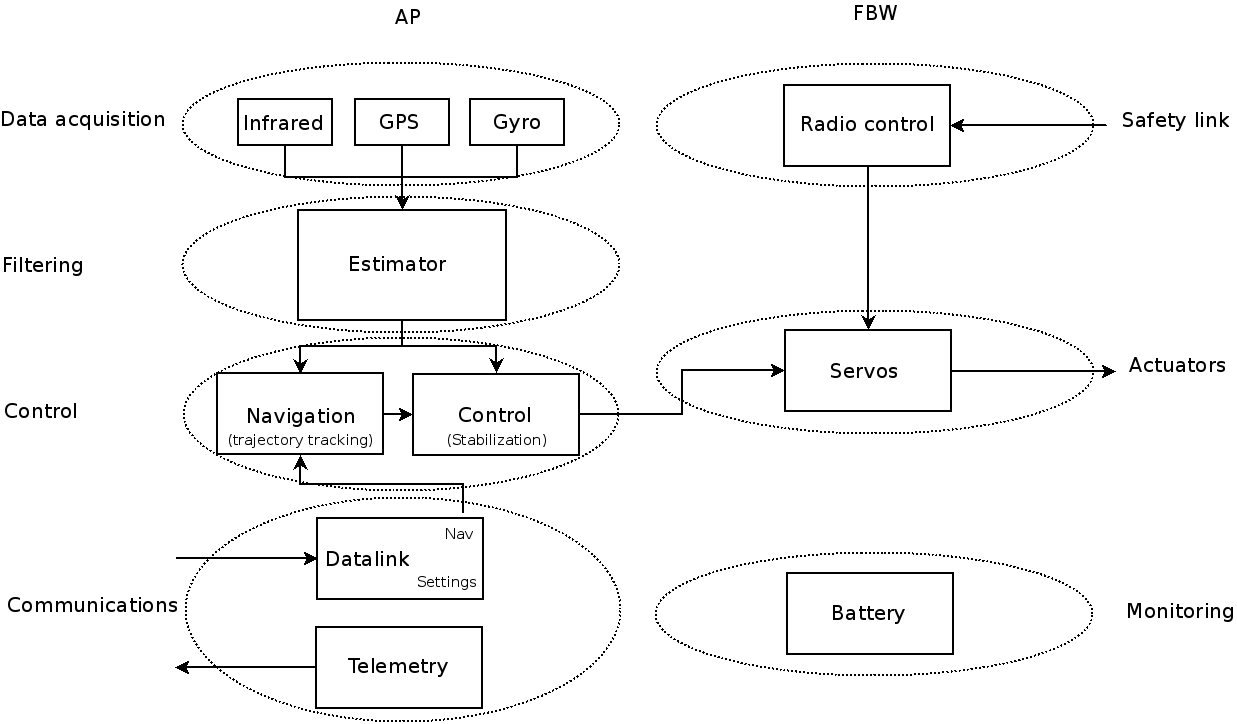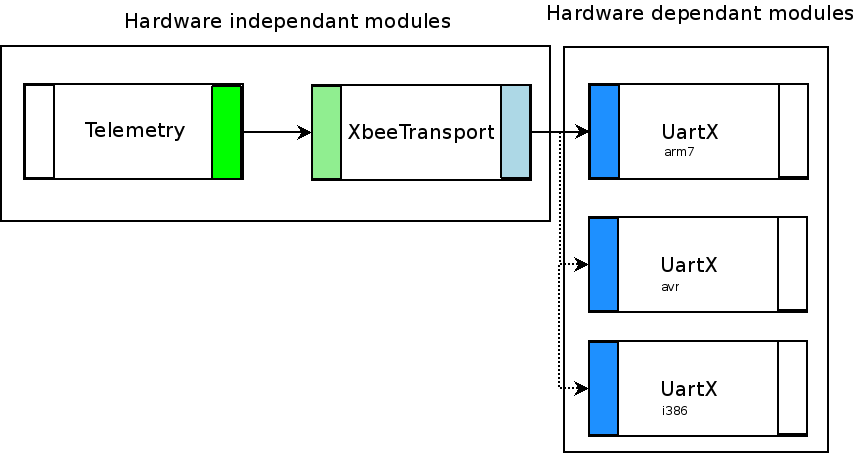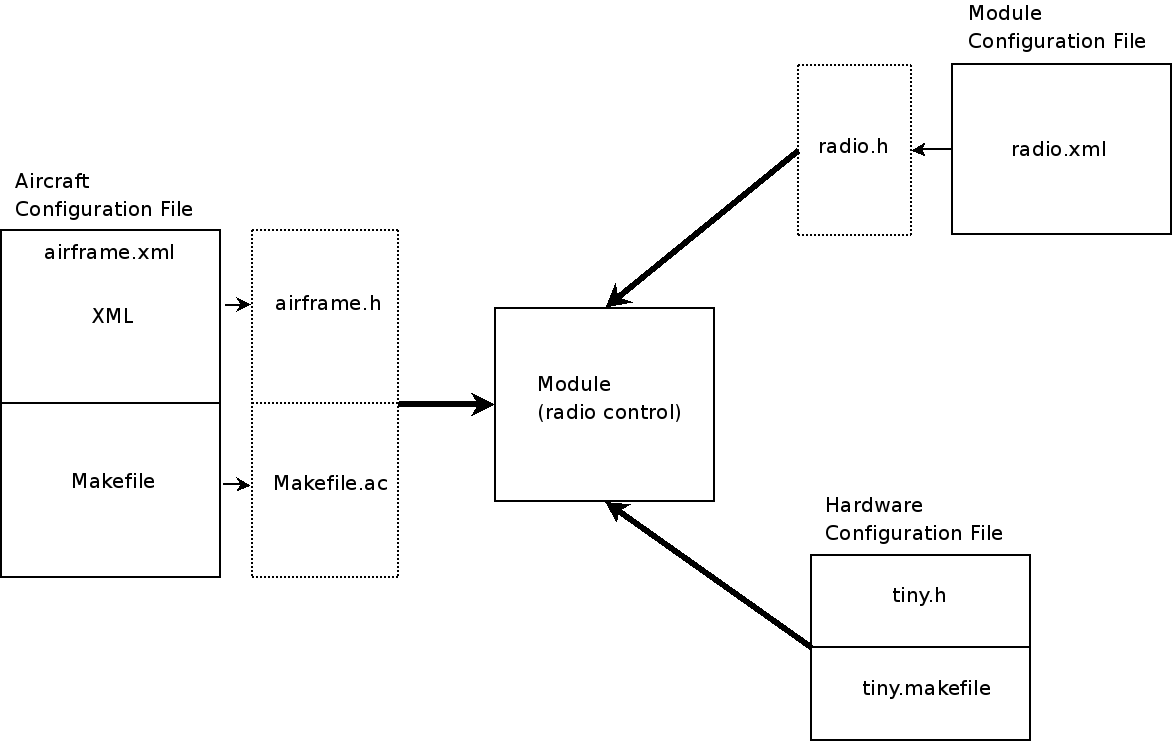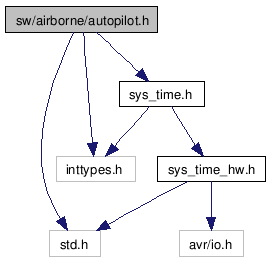Difference between revisions of "DevGuide/DesignOverview"
HectoPascal (talk | contribs) |
Corybarton (talk | contribs) |
||
| Line 184: | Line 184: | ||
=== Conventions === | === Conventions === | ||
== Generating Doxygen Code Documentation == | |||
A way to look at the includes and dependencies is to use the graphs generated with doxygen. After installing Paparazzi, install Doxygen: | |||
sudo apt-get install doxygen graphviz | |||
run the generation tool from the paparazzi3/ directory: | |||
make doxygen | |||
Now Doxygen will have generated html documentation(open this with any web browser) in your paparazzi3/dox/html folder. | |||
To look at a list of all of the files used by the airborne software: | |||
paparazzi3/dox/html/files.html | |||
The main_ap.c will also interest you. | |||
paparazzi3/dox/html/main__ap_8c.html | |||
This is a sample of a Doxygen Graph: | |||
[[Image:Autopilot_8h_incl.png|Include dependency graph for autopilot.h]] | |||
Revision as of 08:53, 21 October 2008
Airborne Functional Diagram
Design Goals
-Static approach -Modularity -Hardware absraction -Runtime efficiency
Static Approach
-only "things that needs to be changed during flight are changeable -maximise compilation time resolutions
advantages Error checking Efficiency Safety/Robustness
Modularity
-Separation of concerns -Maintenability -Interface -C provide no dedicated mechanism for modularity -Main issues with modularity are configuration and dependancies
Hardware abstraction
-Segregate hardware dependant modules
Runtime Efficiency
It's very unlikely that we will change the serial port on which we connected our modem inflight.
bad :
switch(UART) {
case UART0 : UARTO_write(...); break;
case UART1 : UART1_write(...); break;
}
good : #define UartWrite(x) UART ## _write(x) UartWrite(...);
Design Solutions
* Heavy pre-processor usage * C code generation * Heavy Makefile usage * Conventions to define our own module layer
pre-processor
header selection
conf/airframes/funjet1.xml
<makefile> ap.CFLAGS += -DACTUATORS=\"servos_4017_hw.h\" </makefile>
generated var/FJ1/Makefile.ac
ap.CFLAGS += -DACTUATORS=\"servos_4017_hw.h\"
sw/airborne/actuators.h
#include ACTUATORS
expanded by pre-processor to
#include "servos_4017_hw.h"
macros
conf/airframes/funjet1.xml
ap.CFLAGS += -DXBEE_UART=Uart1
sw/airborne/xbee.h
#define __XBeeLink(dev, _x) dev##_x #define _XBeeLink(dev, _x) __XBeeLink(dev, _x) #define XBeeLink(_x) _XBeeLink(XBEE_UART, _x) #define XBeeBuffer() XBeeLink(ChAvailable())
expanded by pre-processor to
Uart1ChAvailable()
C code generation
For problems too complex to solve with the pre processor, we use custom compilers to generate code from a description in xml
example 1 : command laws, aka mixers
conf/airframes/funjet1.xml
<command_laws> <let var="aileron" value="@ROLL * AILEVON_AILERON_RATE"/> <let var="elevator" value="@PITCH * AILEVON_ELEVATOR_RATE"/> <set servo="AILEVON_LEFT" value="$elevator + $aileron"/> <set servo="AILEVON_RIGHT" value="$elevator - $aileron"/> </command_laws>
generated var/FJ1/airframe.h
#define SetActuatorsFromCommands(values) { \
uint16_t servo_value;\
float command_value;\
int16_t _var_aileron = values[COMMAND_ROLL] * AILEVON_AILERON_RATE;\
int16_t _var_elevator = values[COMMAND_PITCH] * AILEVON_ELEVATOR_RATE;\
[....]
command_value = _var_elevator + _var_aileron;\
command_value *= command_value>0 ? SERVO_AILEVON_LEFT_TRAVEL_UP : SERVO_AILEVON_LEFT_TRAVEL_DOWN;\
servo_value = SERVO_AILEVON_LEFT_NEUTRAL + (int16_t)(command_value);\
actuators[SERVO_AILEVON_LEFT] = ChopServo(servo_value, SERVO_AILEVON_LEFT_MIN, SERVO_AILEVON_LEFT_MAX);\
Actuator(SERVO_AILEVON_LEFT) = SERVOS_TICS_OF_USEC(actuators[SERVO_AILEVON_LEFT]);\
example 2 : flight plan
conf/flight plans/example.xml
<block name="For loop (circles wp 1)">
<for from="0" to="3" var="i">
<circle radius="DEFAULT_CIRCLE_RADIUS+ $i*10" wp="1" until="NavCircleCount() > 1"/>
</for>
<deroute block="Standby"/>
</block>
generated var/flight plan.h
Block(29) // For loop (circles wp 1)
switch(nav_stage) {
static int8_t _var_i;
static int8_t _var_i_to;
Stage(0)
_var_i = 0 - 1;
_var_i_to = 3;
Label(for_11)
Stage(1)
if (++_var_i > _var_i_to) Goto(endfor_12) else NextStageAndBreak();
Stage(2)
NavVerticalAutoThrottleMode(RadOfDeg(0.000000));
NavVerticalAltitudeMode(WaypointAlt(3), 0.);
NavCircleWaypoint(3, (DEFAULT_CIRCLE_RADIUS+(_var_i*10)));
if ((NavCircleCount()>1)) NextStageAndBreak();
break;
Stage(3)
Goto(for_11)
Label(endfor_12)
Stage(5)
NextBlock();
break;
}
Makefile
Connecting and configuring modules
ap.CFLAGS += -DDOWNLINK -DDOWNLINK_TRANSPORT=XBeeTransport -DXBEE_UART=Uart1 ap.srcs += downlink.c xbee.c ap.CFLAGS += -DUSE_UART1 -DUART1_BAUD=B9600 ap.srcs += \$(SRC_ARCH)/uart_hw.c
Modules configuration
3 sources of configuration:
* airframe configuration file ( airframe.xml ) which "compiled" to C files and Makefile * specific per module configuration file ( eg radio.xml, flightplan.xml) compiled to C code to allow factorization between airframes. * specific per board configuration file ( eg tiny.h ) to describe modules configuration imposed by board routing
Conventions
Generating Doxygen Code Documentation
A way to look at the includes and dependencies is to use the graphs generated with doxygen. After installing Paparazzi, install Doxygen:
sudo apt-get install doxygen graphviz
run the generation tool from the paparazzi3/ directory:
make doxygen
Now Doxygen will have generated html documentation(open this with any web browser) in your paparazzi3/dox/html folder.
To look at a list of all of the files used by the airborne software:
paparazzi3/dox/html/files.html
The main_ap.c will also interest you.
paparazzi3/dox/html/main__ap_8c.html





